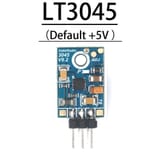Search Results
6/9/2025, 3:42:20 PM
>You have a voltage regulator. Some are faster than others, but all have a non-zero response time. When load current varies, it won't react instantly. If the load current varies quickly, then you need a capacitor on the output of your regulator to keep the output voltage stable. Some regulators also require specific capacitors for proper operation.
>This capacitor is usually called "bulk cap". Depending on the application, it will be something like 10-100µF (sometimes more) and its purpose is to store enough energy to power the circuit until the regulator reacts to a quick change in current demand.
the bottom right capacitor looks exactly like what shows up on google images for 10uF surface mount ceramic capacitor
>The LT3045 is stable with a minimum 10µF ceramic output capacitor.
might still be comfy to add some more like 47-100uF bipolar electrolytic because in jim williams opinion the drawmer DL241 was current starved and he improved the audio signal to noise ratio by making PSU upgrades including swapping the output capacitor from 4.7uF to 1000uF
>This capacitor is usually called "bulk cap". Depending on the application, it will be something like 10-100µF (sometimes more) and its purpose is to store enough energy to power the circuit until the regulator reacts to a quick change in current demand.
the bottom right capacitor looks exactly like what shows up on google images for 10uF surface mount ceramic capacitor
>The LT3045 is stable with a minimum 10µF ceramic output capacitor.
might still be comfy to add some more like 47-100uF bipolar electrolytic because in jim williams opinion the drawmer DL241 was current starved and he improved the audio signal to noise ratio by making PSU upgrades including swapping the output capacitor from 4.7uF to 1000uF
Page 1
